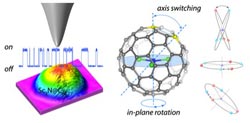Pitt Researchers Invent a Switch That Could Improve Electronics

The incorporation of such single-molecule elements could enable smaller, faster, and more energy-efficient electronics. The research findings, supported by a $1 million grant from the W.M. Keck Foundation, were published online in the Nov. 14 issue of Nano Letters.
“This new switch is superior to existing single-molecule concepts,” said Hrvoje Petek, principal investigator and professor of physics and chemistry in the Kenneth P. Dietrich School of Arts and Sciences and codirector of the Petersen Institute for NanoScience and Engineering (PINSE) at Pitt. “We are learning how to reduce electronic circuit elements to single molecules for a new generation of enhanced and more sustainable technologies.”
The switch was discovered by experimenting with the rotation of a triangular cluster of three metal atoms held together by a nitrogen atom, which is enclosed entirely within a cage made up entirely of carbon atoms. Petek and his team found that the metal clusters encapsulated within a hollow carbon cage could rotate between several structures under the stimulation of electrons. This rotation changes the molecule’s ability to conduct an electric current, thereby switching among multiple logic states without changing the spherical shape of the carbon cage. Petek says this concept also protects the molecule so it can function without influence from outside chemicals.
Because of their constant spherical shape, the prototype molecular switches can be integrated as atom-like building blocks the size of one nanometer (100,000 times smaller than the diameter of a human hair) into massively parallel computing architectures.
The prototype was demonstrated using an Sc3N@C80 molecule sandwiched between two electrodes consisting of an atomically flat copper oxide substrate and an atomically sharp tungsten tip. By applying a voltage pulse, the equilateral triangle-shaped Sc3N could be rotated predictably among six logic states.
The research was led by Petek in collaboration with chemists at the Leibnitz Institute for Solid State Research in Dresden, Germany, and theoreticians at the University of Science and Technology of China in Hefei, People's Republic of China. The experiments were performed by postdoctoral researcher Tian Huang and research assistant professor Min Feng, both in Pitt’s Department of Physics and Astronomy.
Media Contact
More Information:
http://www.pitt.eduAll latest news from the category: Power and Electrical Engineering
This topic covers issues related to energy generation, conversion, transportation and consumption and how the industry is addressing the challenge of energy efficiency in general.
innovations-report provides in-depth and informative reports and articles on subjects ranging from wind energy, fuel cell technology, solar energy, geothermal energy, petroleum, gas, nuclear engineering, alternative energy and energy efficiency to fusion, hydrogen and superconductor technologies.
Newest articles

Superradiant atoms could push the boundaries of how precisely time can be measured
Superradiant atoms can help us measure time more precisely than ever. In a new study, researchers from the University of Copenhagen present a new method for measuring the time interval,…

Ion thermoelectric conversion devices for near room temperature
The electrode sheet of the thermoelectric device consists of ionic hydrogel, which is sandwiched between the electrodes to form, and the Prussian blue on the electrode undergoes a redox reaction…

Zap Energy achieves 37-million-degree temperatures in a compact device
New publication reports record electron temperatures for a small-scale, sheared-flow-stabilized Z-pinch fusion device. In the nine decades since humans first produced fusion reactions, only a few fusion technologies have demonstrated…





















